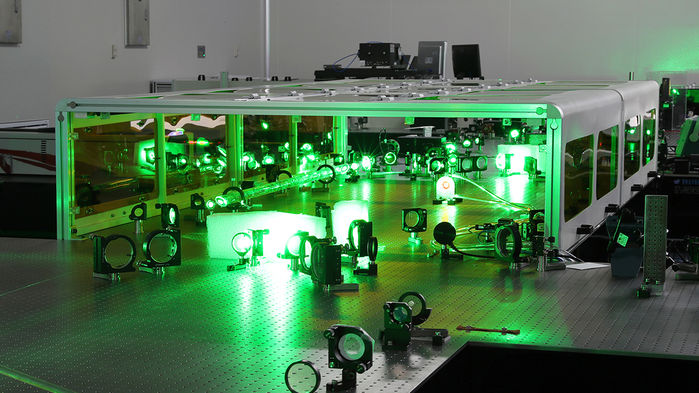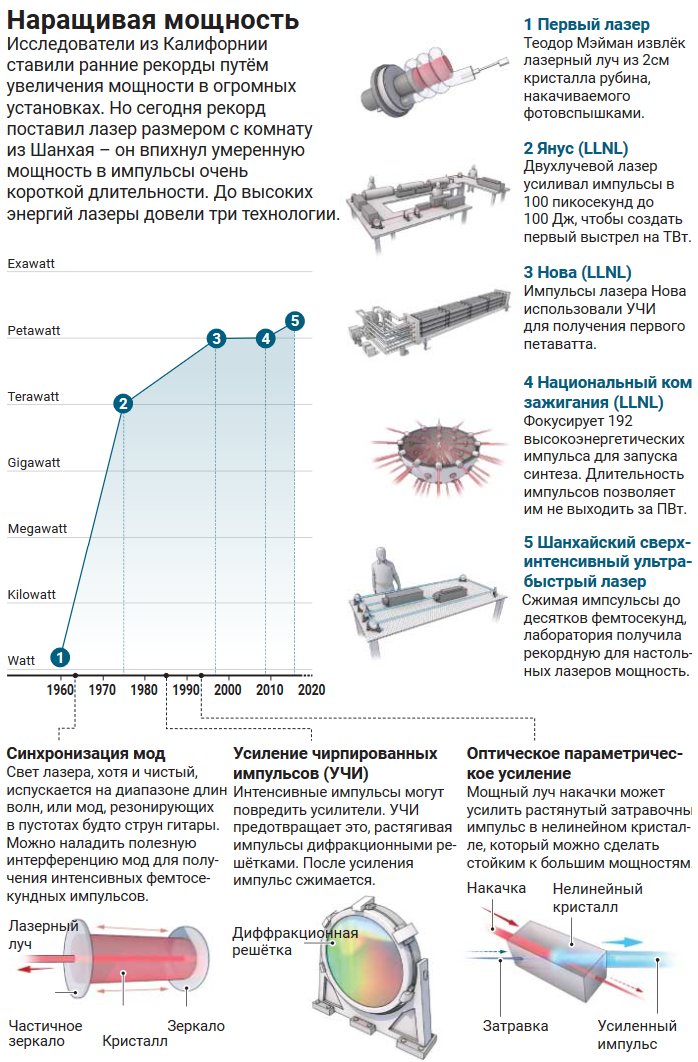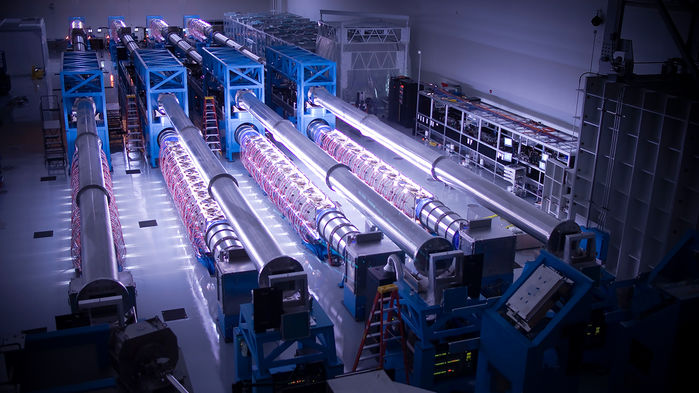Physicists are planning to build a huge power lasers that can break the empty space

Inside a close laboratory in Shanghai (China), physicist Juxin Li [Ruxin Li] and his colleagues set records with the help of the most powerful light impulses that the world has seen. At the heart of their laser called the Shanghai Ultra-Intensive Ultra-Fast Laser Installation (Shanghai Superintense Ultrafast Laser Facility, SULF) is a single sapphire cylinder doped with titanium about the size of a large plate. Once the light in the crystal lights up, it passes through a system of lenses and mirrors, and turns into impulses of incredible power. In 2016, the installation reached a power of 5.3 PW (petawatts, 10 15 W). However, in Shanghai, every time the laser starts, the light does not go out. Although these impulses are extremely powerful, they are also extremely short - each of them lasts no more than one trillionth of a second. Now researchers are updating their laser and are hoping to break their own record by the end of this year, creating a pulse of 10 PW, which is 1000 times higher than the power of all the power grids of the world.
But the group’s ambitions don't end there. This year, Lee and his colleagues are going to start building a 100 PW laser, called the “Station of Extreme Light” (SEL). By 2023, he should be able to start impulses in a room 20 meters underground, exposing targets to extreme temperatures and pressures not encountered on Earth — this will be a celebration for all astrophysicists and materials scientists. Also, the laser will be able to demonstrate a new way to accelerate particles, which will find application in medicine and high-energy physics. But the most interesting thing, according to Lee, will be to show how light can pull electrons and their counterparts out of antimatter, positrons, out of empty space - this phenomenon is known as the “vacuum gap”. This will be a stunning demonstration of the interchangeability of matter and energy, which is postulated by the famous Albert Einstein equation, E = mc 2 . Although nuclear weapons are known to transform matter into a huge amount of heat and light, the reverse process is not so easy to start. But Lee says SEL will handle this. “It will be very exciting,” he says. “It will mean that you can create something from nothing.”
The Chinese group of scientists "definitely serves as the avant-garde" on the road to 100 PW, says Philip Bucksbaum, an atomic physicist at Stanford University. But they have enough rivals. In the next few years, devices with a capacity of 10 PW will have to be made in Romania and the Czech Republic as part of the European research Extreme Light Infrastructure , although this project recently postponed the construction of a 100 PW laser. Russian physicists have developed a 180 PW laser setup with the Exawatt Center for Extreme Light Studies ( XCELS ) project [ not just developed - the project is already included in the list of megaprojects of 2010-2020 / approx. trans. ], and the Japanese made a proposal to create a device with a capacity of 30 PW.
Scientists from the United States dropped out of high-energy competition, according to a study published last month by the National Academies of Science, Engineering and Medicine, the group chaired by Baxbaum. This study calls for the US Department of Energy to plan the construction of at least one high-energy installation, and this gives hope to researchers from the University of Rochester in New York who are developing plans for building a 75 PW laser, the Optical Parametric Amplifier Line (OPAL). She will be able to take advantage of the lasers from OMEGA-EP , one of the most powerful lasers in the USA. “The academy report encourages action,” says Jonathan Zugel, who heads the OPAL project.
Lasers, invented in the 1960s, use an external pumping system, such as a flash lamp, to excite electrons in the atoms of the material underlying a laser — usually a gas, crystal, or semiconductor. When each of these electrons returns to the unexcited state, it emits a photon, which in turn stimulates another electron to emit a photon, and so on. Unlike diverging light rays, photons in a laser generate a tightly packed stream with a specific wavelength.
Since power is energy per unit of time, there are two ways to maximize it: increase the laser energy or decrease the pulse duration. In the 1970s, researchers from the Livermore National Laboratory (LLNL) in California concentrated on the first option, increasing the laser energy, redirecting the rays through additional generating crystals made up of glass with a mixture of neodymium. However, a beam above a certain intensity may damage the amplifiers. To avoid this, the Laboratory had to increase their size, up to tens of centimeters in diameter. But in 1983, Gerard Mourou, now working at the Polytechnic School in Paris, and his colleagues made a breakthrough. He realized that short laser pulses can be stretched in time - making them less intense - with the help of a diffraction grating, which distributes the pulse to its constituent colors. After the light has increased to higher energies, it can be recompressed using a second diffraction grating. The result is a more powerful impulse that does not damage the amplifier.

The amplification of chirped pulses became the basis of high-energy lasers. In 1996, it allowed researchers from LLNL to get the world's first petawatt pulse using the Nova laser. Since then, LLNL has increased the energy of lasers, trying to achieve nuclear fusion. The national ignition complex creates pulses containing an incredible 1.8 MJ of energy in an attempt to heat tiny hydrogen capsules to synthesis temperatures. However, these pulses are relatively long, and they still reach a power of no more than 1 PW.
To increase power, the scientists turned to the time domain of research: they are trying to pack the pulse energy at shorter and shorter periods of time. One approach is to enhance the light in sapphire crystals with the addition of titanium, which produce light with a large frequency spread. In the mirror camera, these pulses, being reflected, jump to and fro, and it is possible to make the most part of the pulse length separate components of frequencies mutually destroy each other, while strengthening each other in a small segment of the pulse with a length of only several tens of femtoseconds. If you pump up such pulses with energy of several hundred joules, you can get a peak power of 10 PW. That is how SULF and other sapphire lasers can beat power records using equipment that fits in a large room, worth only tens of millions of dollars - despite the fact that the National Ignition Complex cost $ 3.5 billion and occupied a ten-story building with an area of three football fields.
Increasing the power of the pulse by an order of magnitude, from 10 PW to 100 PW, will require even more tweaks. One approach is to increase the pulse energy from hundreds to thousands of joules. But sapphire-to-titanium lasers hardly reach such energies, since large crystals, not suffering from high power, tend to emit light at right angles to the beam, thus wasting energy. Therefore, scientists from the SEL, XCELS and OPAL projects are pinning their hopes on optical parametric amplifiers. They take the pulse, stretched by a diffraction grating, and send it to an artificial non-linear crystal, in which the energy of the second pumping beam can be sent to the pulse. Repeated compression of the resulting high-energy impulse raises its energy.
One of the possibilities to approach the mark of 100 PW will be the combination of several pulses - four pulses of 30 PW in the case of SEL and a dozen pulses of 15 PW in the case of XCELS. But it will be very difficult to impose pulses with a duration of just a few fs, ”says Konstantin Hefner, an expert on lasers from LNLL. Even a slight vibration or temperature change can reject them, he says. OPAL, on the other hand, attempts to generate a 75 PW pulse using a single beam.
Muro sees another way to achieve a power of 100 PW: adding a second stage of pulse compression. He suggests using thin plastic films in order to expand the range of pulses with a power of 10 PW, and then compress these pulses to a pair of femtoseconds in order to dramatically increase the power to 100 PW.
When the creators of lasers achieved their power goal, another difficulty awaits them: a very accurate focusing of the rays. Many scientists pay more attention not to the total power, but to the intensity - power per unit area. If you achieve a finer focus, the intensity will increase. If a pulse of 100 PW turns to focus on an area of 3 µm in size, as Lee plans to do on SEL, the beam intensity in this area will reach an incredible 10 24 per cm 2 - this is 25 orders of magnitude, or 10 trillion trillion times greater than that of sunlight reaching Earth.
Such intensities will open the way to breaking the vacuum. According to the theory of quantum electrodynamics , which describes the interaction of electromagnetic fields with matter, the vacuum is not as empty as classical physics claimed. On extremely small time scales, pairs of electrons and positrons emerge from nowhere due to the uncertainty inherent in quantum mechanics. Because of their mutual attraction, they almost immediately annihilate each other.
But a very intense laser, in principle, could separate these particles before they collide. Like any electromagnetic wave, a laser beam contains an oscillating electric field. With increasing intensity, the strength of the electric field also increases. At an intensity of about 10 24 W / cm 2, the field will be strong enough to start breaking the mutual attraction between some of the electron-positron pairs, as Alexander Mikhailovich Sergeev , former director of the Institute of Applied Physics of the Russian Academy of Sciences in Nizhny Novgorod, nowadays President RAS. The laser field will shake these particles, causing them to emit electromagnetic waves - in this case, gamma rays. These rays will generate new electron-positron pairs, and so on, which will lead to a cascade of particles and radiation that can be detected. “It will be a completely new physics,” says Sergeyev. He adds that the energy of gamma photons will be enough to translate atoms into the excited state, and thus a new branch of physics will be born, “nuclear photonics” - the use of intense light to control nuclear processes.

OMEGA-EP amplifiers at the University of Rochester, illuminated by flash tubes, could fuel American high-power laser
One way to break a vacuum is to focus a single laser beam on an empty area in a vacuum chamber. But it will be easier to push the two beams together because it increases the value of the impulse needed to generate a mass for electrons and positrons. In SEL, photons will be pushed indirectly. First, the pulses will knock electrons out of helium. Then other photons from the laser beam will be reflected from the electrons, and turn into high-energy gamma rays. Some of them will collide with the photons of the beam.
Only one fixation of such collisions of photons will become a serious scientific achievement. Classical physics insists that two beams of light must pass through each other without resistance, but some of the early predictions of quantum electrodynamics suggest that approaching photons can sometimes scatter on top of each other. “Such predictions were made back in the early 1930s,” says Tom Heinzl, a theoretical physicist at the University of Plymouth in Britain. “It would be nice to be able to confirm them experimentally.”
In addition to making more powerful lasers, the researchers also want them to shoot faster. Pulsed lamps pumping primary energy into lasers need to be cooled from several minutes to several hours between shots, which complicates research that requires large amounts of data - for example, the study of cases in which photons turn into mysterious dark matter particles that make up most of the mass of the Universe. . “Most likely, in order to see this, you will need to make a lot of shots,” says Manuel Hegelih, a physicist at the University of Texas at Austin.
Higher pulse repetition rates are a key point in using high-energy lasers to control particle beams. In one of the schemes, an intense beam must convert a metal target into a plasma, freeing electrons, which in turn knock protons out of the nuclei from the metal surface. Doctors could use such protons to kill cancerous tumors — and high speed work would make it easier to carry out procedures in small and individual doses.
Physicists dream of particle accelerators operating on the principle of fast laser pulses. When an intense laser pulse collides with a plasma of electrons and positive ions, it pushes the lighter electrons forward, separating the charges and creating a secondary electric field that pulls the ions after the light, like water in the wake of the boat. Such a “laser wake wave” can accelerate charged particles to high energies in space, limited by a pair of millimeters - compared to conventional multi-meter accelerators. Thus, by using magnets, the accelerated electrons can transmit vibrations and create a free-electron laser (free-electron laser, FEL), creating extremely bright and brief X-ray flashes that can illuminate short-term chemical and biological phenomena. FEL on a laser could be much more compact and cheaper than those based on conventional accelerators.
In the long run, electrons accelerated by fast-repetitive laser pulses at powers of the order of PW can drastically reduce the cost of the machine physicists dream of: a 30-kilometer electron-positron collider, which should be the successor of the Large Hadron Collider at CERN. A device based on a 100 PW laser can be no less than 10 times shorter and cheaper than a $ 10 billion machine now planned, said Stewart Mangles, a plasma specialist at Imperial College London.
For a linear collider and FEL, thousands or even millions of shots per second will be needed, which is far beyond modern technology. One of the possibilities that Muro and his colleagues are exploring is to try to combine the output of thousands of fast-firing fiber amplifiers that do not need to be pumped with flash tubes. Another option is to replace flash tubes with diode lasers, which, although expensive, can be cheaper in mass production.
So far, the Li group in China, and its rivals in Russia and the United States are concentrating on power issues. Efim Khazanov, a specialist in lasers from the IAP, says that XCELS will be ready by 2026 - if the government agrees to allocate money for it, about 12 billion rubles (about $ 200 million). In the meantime, OPAL seems to be a relatively profitable option, its value is estimated at between $ 50 and $ 100 million, as Zugel says.
But the first laser to break the vacuum is likely to be Chinese SEL. The International Committee of Scientists last July described the conceptual design of the laser as “unambiguous and convincing,” and Lee hopes to get approval from the government for funds in the region of $ 100 million later this year. Lee says that other countries should not feel as if they remain in the shadow when the most powerful laser in the world turns on - because SEL will work as an international project. Zugel says he doesn’t like “being on the sidelines,” but he admits that the position of the Chinese group is strong. “China is full of attendants,” he says, “and very many very smart people. They are still growing up to a multitude of technologies, but they do it quickly. ”
All Articles